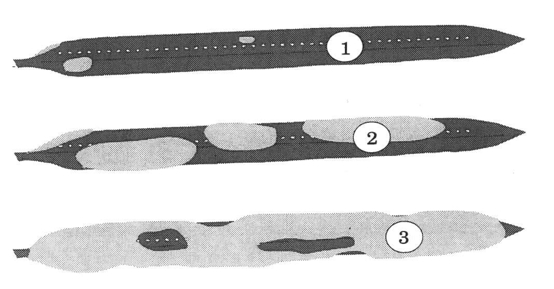7.21.1 Introduction
The aim is to obtain sensitive bioindication of changes in deposition of eutrophicating substances, mainly nitrogen, in green algae on needles, mainly Pleurococcus vulgaris (syn. Protococcus viridis). The present experience shows that the more nitrogen fallout, the thicker the algal cover and the more rapid their colonization. However, also other environmental factors may act as strongly. Therefore some caution in the conclusions is recommended. For the interpretation of data it is especially important to have access to data from subprogrammes Precipitation chemistry (PC) and Throughfall (TF).
This subprogramme can only be applied at sites where Norway spruce is present.
7.21.2 Methods
7.21.2.1 Selection of plots and trees
Select 15-20 small (5-10 m tall) spruces near each other in a fairly open coniferous stand, if feasible near an intensive plot. The spruces should, if possible, stand free from other trees. They must not stand under deciduous trees. They should preferably stand on well-drained soil, have normal crown density and needle size and neither be stunted nor very fast-growing. The branches at eye-height must be so old as to be free from needles on the oldest annual shoot near the trunk. Preferably the same trees should be observed through the years until they are disqualified and must be substituted.
7.21.2.2 Observations
On the needles of three opposing branches at eye-height (ca 160 cm) the following is noted on the main branch axis, using a weak magnifying glass (2-5x):
First note whether algae are missing altogether on the whole branch!
If algae are present note on any twig (axis) of the same branch:
- thickness of algal cover where it is the thickest (Fig. 7.21.1), according to the scale
1 = sparse, patchy or thin
2 = intermediate
3 = very thick, rough structure and easily seen bare spots where coat has disappeared
- youngest shoot where algae can be found; note the age of the shoot
- number of annual shoots which have more than 5 and 50 % needles left respectively
7.21.3 Frequency and conditions for observation
The algae should be observed annually in July-September under good light conditions when the needles are dry.
7.21.4 Quality assurance/Quality control
The main cause of uncertainty for the observer is how to estimate the thickness, since it is practically impossible to give an absolute standard. However, since classes 1 and 3 are relatively distinct care should be taken to pinpoint them. It is recommended not to spend too much time looking for small spots of algae when searching for the youngest shoot with algae.
|
|
|

|
|
Figure 7.21.1. Algal cover classes on spruce needles
|
7.21.5 Data reporting
|
Parameter
|
list
|
description + unit
|
|
ABS
|
IM
|
number of branches (max. 3) on the current tree where algae are missing
|
|
YALG
|
IM
|
youngest shoot with algae (age in years), mean per tree
|
|
COAT
|
IM
|
thickest coating of algae (code), mean of the values from the three branches per tree
|
|
NMED
|
IM
|
number of annual shoots with >50 % needles left, mean per tree
|
|
NMAX
|
IM
|
number of annual shoots with >5% needles left, mean per tree
|
Example files
AL example Excel file
AL example ASCII file
- Data for each individual tree is reported, which makes it possible to calculate, with variation, whether a change is significant or not.
- File identifier SUBPROG states the subprogramme.
- The host tree species is Picea abies. MEDIUM always PICE ABI, list code B4 (Annex 6).
- Report tree number (1- 20) in column TREE.
- Sampling year and month are given as YYYYMM.
- Spatial pool SPOOL refers to the number of trees, here always 1.
- Values are reported as means, status flag is X. General information on flags is given in Chapter 4.
7.21.6 References
Bråkenhielm, S. and Liu, Q., 1995. Spatial and temporal variability of algal and lichen epiphytes on trees in relation to pollutant deposition in Sweden. Water, Air and Soil Pollution 79: 61-74.
Göransson, A. ,1988. Luftalger och lavar indikerar luftföroreningar. SNV Rapport 3562. (In Swedish.)
Peveling, E., Burg, H. and Tenberge, K.B., 1992. Epiphytic Algae and Fungi on Spruce needles. Symbiosis, 12: 173-187.
Söchting, U., Jensen, B., Unger, L., 1992. Epifylfloraen på Rödgran. En undersögelse af belægninger på grannåle. Miljöministeriet, Skov- og Naturstyrelsen og Köbenhavns Universitet, Institut for Sporeplaner. (In Danish with summary in English).
Thomsen, M. G., 1992. Epifyttisk belegg på barnåler i Norge i relasjon til nitrogendeposisjon og klima. Rapp. Skogforsk. 23/92:1-11. (In Norwegian with summary in English